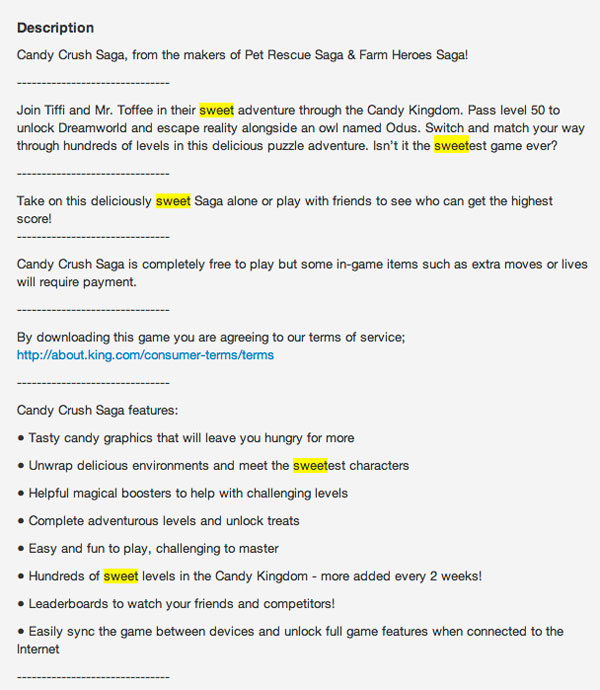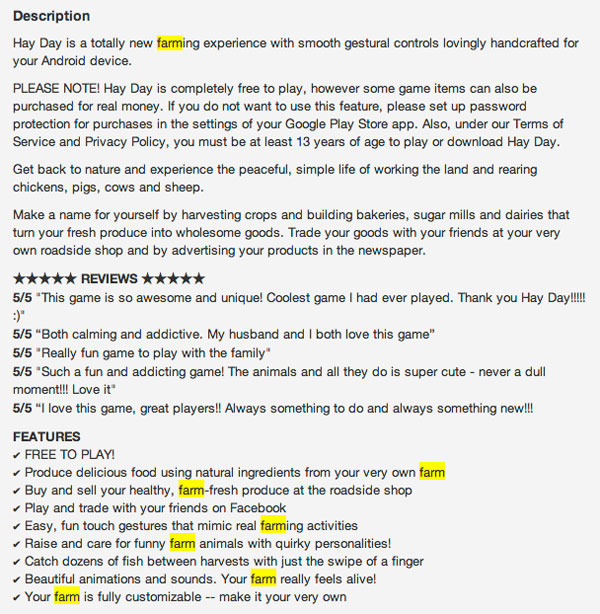Predictions for the Digital Economy in 2026 Report is Live!
Mobile App Insights · Hugh Kimura · July 2014
The Ideal Keyword Frequency In The Descriptions Of Top Android Games
Is it really best to list your target keyword 5 times in your Android description? This post will give you the answer.
In a previous post, we mentioned that you should include a target keyword in your Google Play description five times for best results. But does this really help an app rank for a keyword or is just a myth?
This post will examine three top grossing games on Google Play and find out exactly how many times the top keyword appears in the description of the app. We will not look at keywords that are in the title of the app because they have more of an influence on the rankings.
In addition, we will look at the Traffic and Difficulty characteristics of each keyword and where these apps rank for these keywords.
Candy Crush Saga
The keywords that an app publisher chooses to target can be surprising. One example is the keyword "sweet."
It's not the first thing that comes to mind if I wanted to search for a game like Candy Crush Saga. But apparently it is for a lot of people because it is one of their top keywords. When we do a search on an Android phone, Candy Crush comes up #2 for this keyword.

When we examine the keyword in the Keyword Research module, we find that it has a good amount of traffic and is fairly difficult to rank in the top 10 for.

Since people are searching for it and it is relevant to the game, it is a good keyword to target. The question then becomes: How many times is it in the description of the game on Google Play?

As you can see, the keyword "sweet" appears exactly five times in the description. It is a perfect example of an app that uses a keyword five times to get the ideal result.
Modern War
We mentioned in this post that the word "faction" appears a lot in the reviews of this game. Not all keywords that appear in user reviews are good keywords to target, but this keyword is. The research on this keyword shows that it gets a decent amount of traffic and is fairly hard to rank for.

Although this game does not rank in the top 10 for this keyword, it is the highest ranking keyword that is not included in the title of the game.

Just like with Candy Crush Saga, Modern War also has this target keyword five times in the description of the game.

Hay Day
Finally, we look at a mega game from Supercell. One of Hay Day's target keywords is "farm." This example is a little different from the others, in that the keyword is used seven times in the description.

Will it adversely affect how the app ranks for this keyword? Will Google see this as keyword spamming?
Apparently not because Hay Day still ranks #3 for this keyword. So adding the keyword more than five times does not seem to hurt the rankings.

Since this is a harder keyword to rank for (higher Difficulty Score), one could also make the case that the extra two mentions may have actually helped Hay Day rank higher for this keyword.

Conclusion
These three examples demonstrate that using your target keyword five times in the description of your app will give it the best chance of ranking for that keyword. However, there is no guarantee that it will rank for a keyword.
If you put a target keyword into your description five times and your app does not rank in the top 10 for that keyword, then replace it with a keyword that has a lower Difficulty Score or add it to the title of your app.
Also notice how these keywords are used in these examples. They are part of coherent sentences or phrases that make sense to people, not just the Google search algorithm. It is just as important to sell a person on the benefits of your game, as it is to include keywords in the description.
Even though this is considered best practice on Google Play, don't be afraid to test different ideas and figure out what works best for your app.
How many times do you include your keywords in your Google Play description? Let us know in the comments below.
